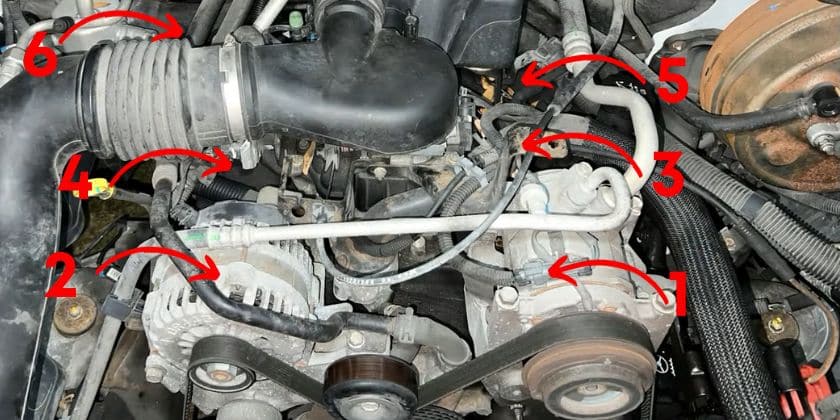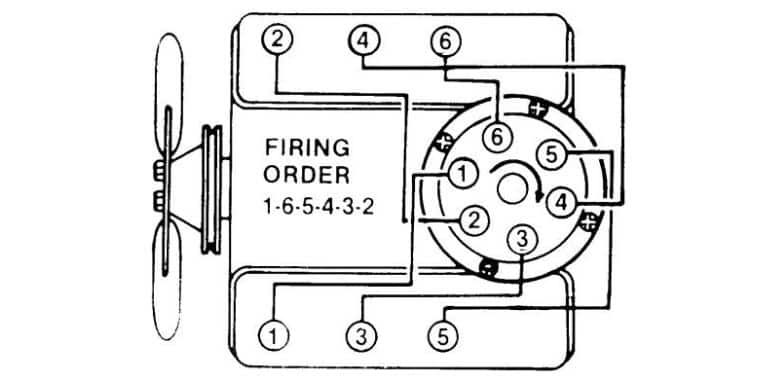TL;DR
The 4.3L Vortec engines come with a firing order of 1-6-5-4-3-2 and a clockwise distributor rotor rotation. Cylinders 1, 3, and 5 are on the driver’s side, while Cylinders 2, 4, and 6 are on the passenger side (when looked from front to back).
One of the most common problems associated with the 4.3L Vortec engines is the fragile distributor cap.
Many GMC and Chevy owners have complained that the distributor caps in their 4.3L Vortec-based vehicles crack or wrap (lose their shape) due to heat.
As a result, moisture or dirt starts to enter the distributor, causing the engine to misfire.
This issue can easily be solved by upgrading to a higher-quality aftermarket cap.
But the problem comes when you try to replace the cap by yourself, as you don’t know the firing order of your engine.
What is the Engine Firing Order?
The firing order is the sequence in which spark plugs ignite the air-fuel mixture in the cylinders.
This sequence is important for multi-cylinder engines, such as the 4.3L Vortec, as it determines the balance and smoothness of the engine’s operation.
It’s carefully designed by the auto manufacturers to ensure that the forces produced by the piston movements are evenly distributed.
This even distribution helps in reducing engine vibrations, minimizing wear and tear on engine parts, and improving overall vehicle comfort.
Additionally, a well-arranged firing order also helps in efficient fuel combustion, leading to better fuel economy and power delivery.
For engines with a distributor, such as 4.3L Vortec, the firing order determines the arrangement of the spark plug wires on the distributor cap.
You need to ensure that these wires are matched according to the firing order, as there can be misfires, rough running, or even engine damage otherwise.
4.3L Vortec Cylinder Layout, Firing Order, and Distributor Rotation Explained
Before talking about the 4.3L Vortec engines’ firing order, it’s important to discuss their cylinder layout.
4.3L Vortec Cylinder Layout

Being part of the V6 family, the 4.3L Vortec engines come with six cylinders.
These cylinders are arranged in a V shape, which gives you three rows of two opposing cylinders.
If you look from the front of the vehicle, the Cylinders 1, 3, and 5 are on the driver’s side, and the Cylinders 2, 4, and 6 are on the passenger’s side, as shown in the above picture.
4.3L Vortec Distributor Firing Order And Rotation

As you can see from the above picture, the firing order on the 4.3L Vortec engines is 1-6-5-4-3-2 – no matter if they’re from 92 Chevy or 2001.
It means that Cylinder 1 ignites first, then Cylinder 6, then Cylinder 4, and so on – with Cylinder 2 being the last.
You need to remember this sequence when arranging the spark plug wires on the distributor cap.
As far as the distributor is concerned, it’s mounted at the rear of the engine, with the top side near the firewall and clockwise rotation.
How to Check the Firing Order Of An Engine?
There are a number of ways to find out the firing order of any engine.
The first thing you should check is your vehicle’s manual. The firing order is usually listed in the engine specifications section of the service manual.
This section also provides technical details about the engine, including dimensions, capacities, maintenance schedule, etc.
The next place to look at is the intake manifold, especially if you’ve lost your service manual.
Many auto manufacturers, usually in older vehicles, stamp the firing order onto the intake manifold for easy reference during maintenance or repair work.
If that’s not the case with your vehicle and there’s no info on the intake manifold, I recommend you search for it online.
There are many auto-related subreddits and forums where you can get the info about your engine’s firing order.
If even Google and forums don’t do any help, which would be rare, the last option is to open up the engine to determine the firing order by yourself.
Although varying from engine to engine, it usually includes removing the cylinder head cover, identifying spark plug holes, and rotating the crankshaft to check the movement of the piston checking tool in the spark plug holes.
Honestly speaking, this whole process is quite technical and lengthy for most DIY enthusiasts and should only be done by a certified professional.
Frequently Asked Questions
What is the Firing Order in 2000-2004 4.3L Vortec?
The firing order in 2000-2004 4.3L Vortec engines is 1-6-5-4-3-2.
What is the Firing Order on a 92 4.3L Chevy?
The same goes for the older 92 4.3L Chevy. Its firing order is 1-6-5-4-3-2, with cylinders no. 1, 3, and 5 on the driver’s side (front to back) and cylinders no. 2, 4, and 6 on the passenger side (front to back).
How Do You Diagnose a Bad Distributor Cap?
To diagnose a bad distributor cap, you need to look out for common issues with it, such as the engine cranking but the car not starting, the car shaking/vibrating, squealing noise coming from the engine area, the Check Engine warning light on the instrument panel, etc.
You can also visually inspect the cap from inside and out for any signs of damage or wear.
What Are The Symptoms of Bad Spark Plugs?
Some of the common symptoms associated with bad spark plugs include rough idling, difficulty in starting the engine, increased fuel consumption, and a noticeable lack of acceleration.
Sometimes, you’ll also feel that the vehicle is not accelerating as fast as it used to be.
That said, you may want to check other components in the engine, too, before reaching any conclusion.
That’s because many of those components, such as the O2 sensor, ignition coil, fuel injectors, mass airflow sensor, etc., give more or less similar symptoms upon malfunctioning.
A code scanner can help you in this regard, as it’ll only show the error codes related to the faulty component.
